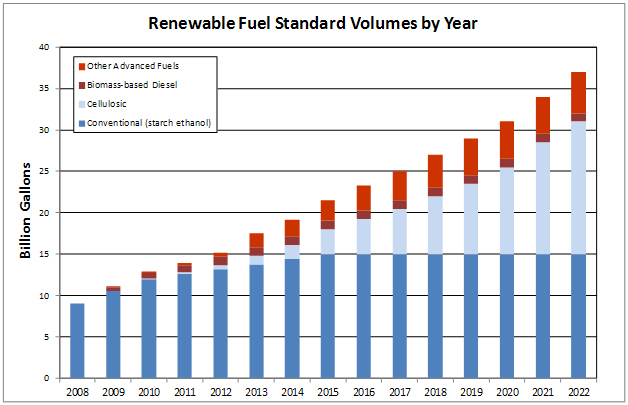Renewable Fuel Standard
The Renewable Fuel Standard (RFS) is a federal program that requires transportation fuel sold in the United States to contain a minimum volume of renewable fuels.
The RFS originated with the Energy Policy Act of 2005 and was expanded and extended by the Energy Independence and Security Act of 2007 (EISA). The RFS requires renewable fuel to be blended into transportation fuel in increasing amounts each year, escalating to 36 billion gallons by 2022. Each renewable fuel category in the RFS program must emit lower levels of greenhouse gases (GHGs) relative to the petroleum fuel it replaces.

RFS Requirements
The U.S. Environmental Protection Agency (EPA) administers the RFS program and establishes the volume requirements for each category based on EISA-legislated volumes and fuel availability. EPA tracks compliance through the Renewable Identification Number (RIN) system, which assigns a RIN to each gallon of renewable fuel.
Entities regulated by RFS include oil refiners and gasoline and diesel importers. The volumes required of each obligated party are based on a percentage of its petroleum product sales. Obligated parties can meet their renewable volume obligations (RVOs) by either selling required biofuels volumes or purchasing RINs from parties that exceed their requirements. Failure to meet requirements results in a significant fine. Details of the program are available on EPA's RFS website.
Renewable Fuels Categories
Each year, the RFS program requires the sale of specified volumes of renewable fuels according to the categories below. EISA established life cycle GHG emissions thresholds for each category, requiring a percentage improvement relative to the emissions baseline of the gasoline and diesel they replace.
- Conventional Biofuel: Any fuel derived from starch feedstocks (e.g., corn and grain sorghum). Conventional biofuels produced in plants built after 2007 must demonstrate a 20% reduction in life cycle GHG emissions.
- Advanced Biofuel: Any fuel derived from cellulosic or advanced feedstocks. This may include sugarcane or sugar beet-based fuels; biodiesel made from vegetable oil or waste grease; renewable diesel co-processed with petroleum; and other biofuels that may exist in the future. Nested within advanced biofuels are two sub-categories: cellulosic biofuel and biomass-based diesel. Both biomass-based diesel and cellulosic biofuel that exceed volumes in their respective categories may be used to meet this category. Fuels in this category must demonstrate a life cycle GHG emissions reduction of 50%.
- Biomass-Based Diesel: A diesel fuel substitute made from renewable feedstocks, including biodiesel and non-ester renewable diesel. Fuels in this category must demonstrate a life cycle GHG emissions reduction of 50%.
- Cellulosic Biofuel: Any fuel derived from cellulose, hemicellulose, or lignin—nonfood-based renewable feedstocks. Fuels in this category must demonstrate a life cycle GHG emissions reduction of at least 60%.